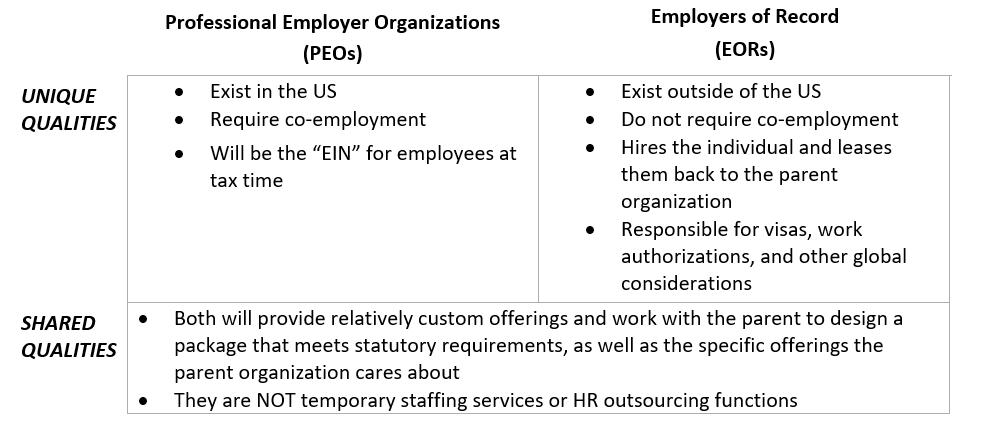PEO and EOR Considerations | Deloitte US has been saved
By Danielle Feinblum, Cliff Mansfield, and Andrew Heller
When the Human Capital (HC) DealMakers community came together recently, we had a robust discussion about PEOs, EORs, what those acronyms mean, and considerations for if/when to leverage them. This blog will provide a high-level overview of both, but if you’re looking for further detail on PEOs, we suggest checking out, To PEO or not to PEO in M&A Transactions.
What are PEOs and EORs?
Professional Employer Organizations (PEOs) and Employers of Record (EORs) both offer HR support services for organizations that lack the scale to require their own HR functions.

When might an organization consider leveraging a PEO and/or EOR?
- Organizations of 100 employees or fewer (due to the expense, this is a typical breakeven point).
- Small groups of employees in lower-cost locations where payroll expense may be minimal.
- When the long-term strategy in a new location (e.g., no existing legal entity) is uncertain, but short-term, the employees are required in that location.
- To bridge the gap between close and a buyer’s operational readiness to stand up a new legal entity or support function.
- Typically, this is not a long-term solution given the high expense (~12-18 months).
- To reduce or remove the reliance/duration for a transition service agreement (TSAs).
What should an organization consider when determining if a PEO or EOR is the right strategy for them?
- Payroll cost/headcount cost: Most PEOs and EORs charge a percentage of payroll to provide services. Organizations should consider the cost of the PEO or EOR compared to their payroll costs.
- Cost/time to stand up a new legal entity and provide HR services: Conduct a cost benefit analysis to weigh the cost of the PEO or EOR with the cost of accelerating any timeline to standup a legal entity or HR services.
- Cost/time to set up relationship with the PEO/EOR: Typically, the PEO/EOR is able to work quickly (2-10 weeks depending on country and needs), but delays could stem from processes Procurement teams must follow to verify an organization as an approved services provider.
- Location: Determine if the PEO/EOR can support your country requirements. Most countries will allow an EOR, but there are country specific laws/norms that must be followed.
- Employee experience: Change management / cultural adoption should be considered when communicating to employees as they become managed by a PEO/EOR or folded back into the parent company.
- Benefits: Investigate what benefits they offer and if they can provide Benefits that meet your need, and employee expectations.
- Tech: Consider what their tech stack looks like, and if it’s compatible with yours.
- Financial stability: Review the financial stability of the organization and if it meets your risk standards.
If you’re interested in using a PEO or EOR, or believe you may encounter it in the future, we advise connecting with your Legal team to understand if they are an option, and any company or industry specific considerations.
Monthly our Human Capital Mergers, Acquisitions, and Restructuring (M&A/R) team connects with HR professionals focused on M&A/R work (aka Human Capital “DealMakers”) across every industry. During these sessions we discuss topics that are top of mind for them as they support their companies. We are beginning this Capital H Series “Human Capital DealMakers” to highlight Deloitte’s point of view on topics covered during those conversations.
If you, or someone on your team, is focused on HR M&A/R work and are interested in joining our monthly calls, please reach out to the Human Capital DealMakers Mailbox.
Authors:

